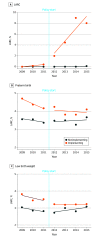Association of Medicaid Reimbursement for Immediate Postpartum Long-acting Reversible Contraception With Infant Birth Outcomes
- PMID: 35006260
- PMCID: PMC8749696
- DOI: 10.1001/jamapediatrics.2021.5688
Association of Medicaid Reimbursement for Immediate Postpartum Long-acting Reversible Contraception With Infant Birth Outcomes
Abstract
Importance: Together, preterm birth and low birth weight are the second-leading cause of infant mortality in the US and occur disproportionately among Medicaid-paid births and among the infants of Black birthing persons. In 2012, South Carolina's Medicaid program began to reimburse hospitals for immediate postpartum long-acting reversible contraception (LARC) separately from the global maternity payment.
Objective: To examine the association between South Carolina's policy change and infant health.
Design, setting, and participants: This population-based cohort study using a difference-in-differences analysis included individuals with a South Carolina Medicaid-paid childbirth between January 2009 and December 2015. Data were analyzed from December 2020 to July 2021.
Exposures: Medicaid-paid childbirth after March 2012 in South Carolina hospitals that had implemented the policy.
Main outcomes and measures: Immediate postpartum LARC uptake, subsequent birth within 4 years, subsequent short-interval birth, days to subsequent birth, subsequent preterm, and low-birth-weight birth within 4 years.
Results: The study sample included 186 953 Medicaid-paid births between January 2009 and December 2015 in South Carolina (81 110 births from 2009 to 2011, 105 843 births from 2012 to 2015, and 46 414 births in exposure hospitals). The policy was associated with an absolute 5.6-percentage point (95% CI, 3.7-7.4) increase in the probability of receiving an immediate postpartum LARC overall, with significantly larger effects for non-Hispanic Black individuals than non-Hispanic White individuals (difference in coefficients 3.54; 95% CI, 1.35-5.73; P = .002). The policy was associated with a 0.4-percentage point (95% CI, -0.7 to -0.1) decrease in the probability of subsequent preterm birth and a 0.3-percentage point (95% CI, -0.7 to 0) decrease in the probability of subsequent low birth weight. No significant difference in the association between the policy and preterm birth or low-birth-weight birth between non-Hispanic Black and non-Hispanic White individuals was found. The policy was associated with a 0.6-percentage point (95% CI, -1.2 to -0.1) decrease in the probability of short-interval birth and a 27-day (95% CI, 11-44) increase in days to next birth among non-Hispanic Black individuals. The policy was associated with a significant decrease in the probability of a subsequent birth overall; however, confidence in this result is attenuated somewhat by nonparallel trends for this outcome before the policy change.
Conclusions and relevance: Findings of this cohort study suggest policies increasing access to immediate postpartum LARC may improve birth outcomes but should be accompanied by other policy efforts to reduce inequity in these outcomes.
Conflict of interest statement
Figures


Comment in
-
Association of Comprehensive Immediate Postpartum Contraception With Infant Outcomes.JAMA Pediatr. 2022 Mar 1;176(3):233-235. doi: 10.1001/jamapediatrics.2021.5695. JAMA Pediatr. 2022. PMID: 35006238 Free PMC article. No abstract available.

